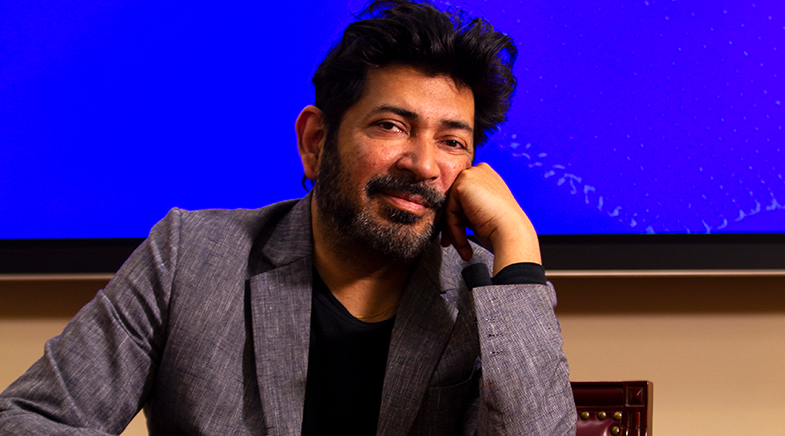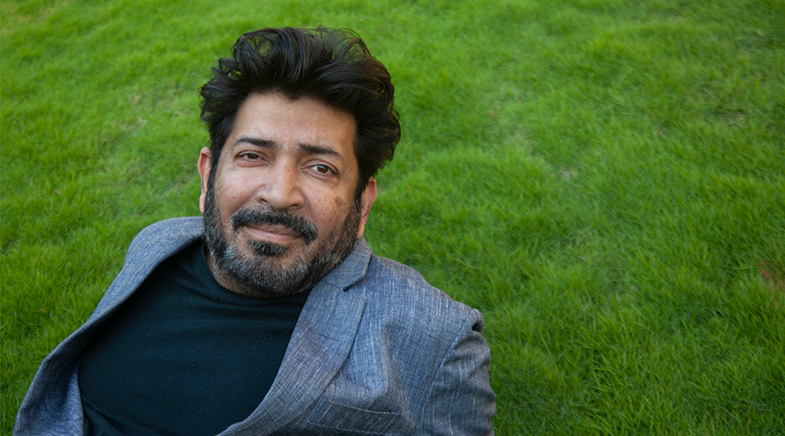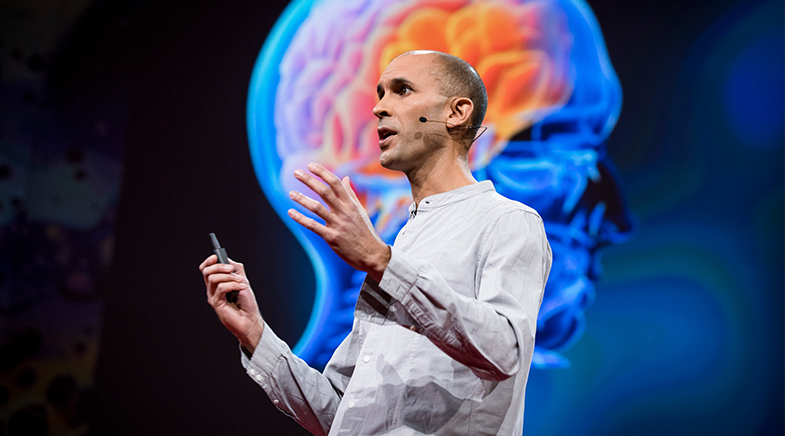A whole new way of looking at medicine: Siddhartha Mukherjee
-
- from Shaastra :: vol 02 issue 01 :: Jan - Feb 2023

A deeper understanding of the cellular basis of disease raises hopes of curing hitherto-incurable diseases, says Siddhartha Mukherjee.
The worlds of science and the humanities, often (erroneously) considered parallel universes, fuse artfully for Siddhartha Mukherjee. The New York-based oncologist, writer and entrepreneur is a public intellectual, a scientist-celebrity, and a doctor-writer who is as much at ease with the poetry of Wallace Stevens as with the immunology of cancer. His broad interests and passion for art show up in his science writing, which is rich in literary allusions and intensely human narratives. Mukherjee's first book, The Emperor of All Maladies, won the Pulitzer Prize for non-fiction in 2011. It was an engaging history of cancer and our continuing efforts to understand and cure it. His second book, The Gene, was a history of molecular genetics from its first stirrings with Gregor Mendel to the early attempts of scientists at gene editing. His third book, The Song of the Cell, published in October 2022, is an attempt to look at biology through its most basic component, the cell. The cell is the equivalent of the atom in physics. To understand life, we must understand the cell. The cell, as Mukherjee suggests in his book, is also a powerful means of treating cancer.
Although not as widely publicised as his books, his company Immuneel Therapeutics – which he set up in Bengaluru in partnership with Biocon founder Kiran Mazumdar-Shaw – has been at the forefront of a rapidly advancing field of cancer therapy. Through his medical practice, entrepreneurship and writings, Mukherjee has been an evangelist for cell-based therapy, a method of harvesting whole cells from a patient, tweaking them and putting them back to treat illnesses from cancer to autoimmune diseases. On a recent visit to India, Mukherjee talked to Shaastra magazine about the immense potential of cell-based therapies. Excerpts:
There is a lot of optimism in your books about the future of medicine. This is especially evident in your most recent book, The Song of the Cell. What are the scientific developments that give you this optimism?
I'm particularly optimistic about cell-based therapies because we are getting to the level of a greater degree of complexity with individual medicines. In some ways, all medicines are cell-based therapies – or rather, cell-directed therapies. So, the optimism arises because the more we understand about cellular pathology and the pathology that's the basis for disease, the more optimistic I become about the possibility of curing diseases. We have made incredible strides against haemophilia and sickle cell anaemia. Now, we've been living with thalassemia and sickle cell anaemia since the beginning of mankind. We understood the molecular basis of sickle cell anaemia only in the 1970s and 1980s.
Linus Pauling, famously, was among the people to identify sickle cell anaemia. He called it a molecular disease. But it wasn't until we could understand the cellular pathology of sickle cell anaemia, and the development of bone marrow transplants and genetic therapies, that we were ultimately able to solve the therapeutic problem of sickle cell anaemia or beta thalassemia. So, the optimism comes from the fact that understanding cellular pathology and the cellular basis of disease is creating a whole new way of looking at medicine, and thereby allowing us to cure and treat diseases that were previously thought to be incurable and untreatable.
There is a long distance to travel from understanding cellular pathology to treating diseases. When the human genome was sequenced, there were stories about how great things would be, but it didn't turn out that way. There are still lots of complexities in using genome information. What are the big challenges in cell-based therapies?
One of the big challenges is to figure out how to manipulate cells, especially how to manipulate cells in the body and outside the body. Take the challenge, for instance, of Type 1 diabetes. We have known the pathophysiology of Type 1 diabetes for many years. It is an autoimmune attack on islet cells that make insulin in the body. One kind of therapy for the disease is to provide insulin by injection. That has complications, as you know. Now, there are finally attempts to create or cultivate or make autologous islet cells – and then create (or recreate) – a mini pancreas in the body. That is this process. Insulin was discovered in 1920. It is over 100 years since that discovery that we're finally using cell-based therapy to attack Type 1 diabetes and potentially treat and cure Type 1 diabetes. This is the knowledge cycle.

The knowledge cycle takes a long time. The Human Genome Project was just the beginning of a new knowledge cycle. And, over time, that knowledge cycle will yield – and has already begun to yield – a real understanding of the complexities. The human genome is just a template. From the human genome, we need to understand the human cellular atlas, how the human genome is utilised by different cells to carry out their functions, how those functions become dysfunctional in the case of diseases, and then potentially how to use various modalities, including cell-based therapy, to change the pathophysiology and make it therapeutic.
Can you give some specific examples of the advances in the last year or two?
Treatments and potential cures for sickle cell anaemia, beta thalassemia; clinical trials that use cell-based therapies such as T cell therapies for malignant diseases such as leukaemias and lymphoma and myeloma; cell-based therapies that are directed at the immune system that can reactivate the immune system against cancer; checkpoint inhibitors, cell-based and cell-activating therapies that can change the course of autoimmune diseases such as multiple sclerosis. I think the FDA will approve 50 or 60 drugs this year. In many ways, the genesis of these drugs is the understanding of pathophysiology, which ultimately depends on understanding the cellular basis of disease.
"The knowledge cycle takes a long time. The Human Genome Project was just the beginning of a new cycle. And over time, that has begun to yield a real understanding of the complexities."
A decade from now, how do you see cell-based therapies coexisting with treatments based on small molecules and biologics?
I think they will be complementary. One of the questions the book raises is the question of universality. Ultimately, all diseases are cellular diseases. And so, in some ways, it's almost an answer that seems to be universal: that all medicines are going to somehow affect cellular function. They may attack particular molecules or be directed at particular molecules within cells, but ultimately all are impinged on the behaviour, the properties, of cells. In the future, there will be a mix and match in which we use small molecules, live cells, and potentially even devices to modify the behaviour of cells so that ultimately you get a therapy that's a therapeutic modality.
What about the costs? How quickly can such therapies spread to smaller towns and remote areas? You need a lot of skill and infrastructure to do this, don't you?
That's correct. We need a lot of skill and infrastructure. But the question of price and cost always has to begin with the question of starting the journey. You can't bring the prices of anything down without starting the journey, without actually doing it. The first genome was sequenced at a billion dollars. Now I'm sequencing all exomes for hundreds of dollars. That is a six log-fold decrease in the span of about ten-odd years. I think the question of price and cost is always evolving. At Immuneel, for instance, we are trying everything possible to bring the cost down. There is a certain floor that we have to meet because we have to be safe, we have to be sterile, and we have to be effective. We want to prevent rogue actors from making rogue claims about cellular therapy. And we have to match international standards. But we have started this journey and we intend to finish it.
What else can you do at Immuneel here?
We're doing so many things. You've seen the spectacular Phase IIB data on CD19 product. It is really world-standard data. We are now moving on to several other products. Some of them are proprietary. There's a deep cycle of innovation that we have started at Immuneel. And, of course, there is a strong effort at being conscious of the price so that we can deliver drugs to as many people as possible. There is always a limit to the affordability, but we are making every effort to be conscious of the price while trying to bring this product to the market.
There have been several start-ups in India in biotech in the past 20 years, but none that has become big. They may have scientific and technical problems, but even if they don't, they find it very hard to raise money after a point in India and become American companies. Why is this happening? Can Indian companies become big?
I think they can. The question is of retaining talent, rewarding talent, rewarding success, and creating an ecosystem of success. Our effort is to challenge our scientists at Immuneel. The quality of the work that the scientists are producing is absolutely world-class. I don't see any difference between this facility and any facility of similar capacity anywhere in the world. There's so much of pride in what has gone into building this. There is a start-up mentality here, but it is not a mentality that "we're going to take this and fly off to the United States." We cannot. The infrastructure that we have built here is local infrastructure and it will persist as local infrastructure. Ultimately, there will be returns to the world at large as we move forward.

"Ultimately, all diseases are cellular diseases. And so, all medicines are going to somehow affect cellular function."
What sort of ecosystem do you have here that is conducive to such work?
A lot of talent, a lot of passion, a lot of interest. We have talked within Immuneel of appropriately rewarding talent and innovation, right from clinicians, scientists, nurses, obviously, engineers, people who work on process. At every level we are encouraging innovation and trying to reward it so that we can really fulfill the cycle that is so essential to making new products in the world. We are doing fundamental science. We are working with several universities, some of which have been made public and some of which are private. We have an enviable advisory board, including the best of the best in the field. So, we have made some quite basic scientific work, including the development of new therapeutic products.
"I'm optimistic about cell-based therapies because we are getting to the level of a greater degree of complexity with individual medicines."
How do you see treatment moving from therapies specific to a patient to general treatments? From autologous to allogenic approaches?
Many ways, some of which have been explored already and some others we are exploring, particularly at Immuneel. Some of them involve removing the determinants that may prevent us from using allogenic products. Some of them involve completely different types of cells, completely different cellular modalities that are not restricted to autologous products. But can we extend it into the allogenic setting? This is, in fact, some of the basic science that we are doing. We are doing a lot of work to create allo products. And that will, of course, be a game changer in terms of price reduction, because we don't have to cultivate each one for each individual person.
You talk about the "new human" early in your book. What significance does it have to evolution? Are we directing our own evolution?
The numbers are so small that I don't think we are directing evolution in a macroscopic sense. I have a very specific use of the words ‘new human'. I talk about the idea that we are using these new therapies to alleviate suffering. And often, in doing so, we are manipulating our cells, our bodies, in ways that are quite unprecedented. To me, that is much more interesting than this science fiction version, the robotic version of the new human. I am less interested in the Augmented New Human and more interested in the new human who is suffering through diseases that we have been able to treat and cure. And that is the sense in which I mean the new human.
We spoke about small molecules and biologics. What will be the role of diet and lifestyle in treating cancer?
We have done a lot of work on this, and we continue to work on this. We have specifically looked at cancer metabolics. Cancer cells have a unique metabolic profile. And it is an unexploited arena in cancer biology, in which the metabolic inputs into cancer have not been appropriately understood or exploited. We have created platforms, in our clinical trials, to look at how diet can be used as a potential modality for cancer therapeutics.
See also:
Have a
story idea?
Tell us.
Do you have a recent research paper or an idea for a science/technology-themed article that you'd like to tell us about?
GET IN TOUCH














